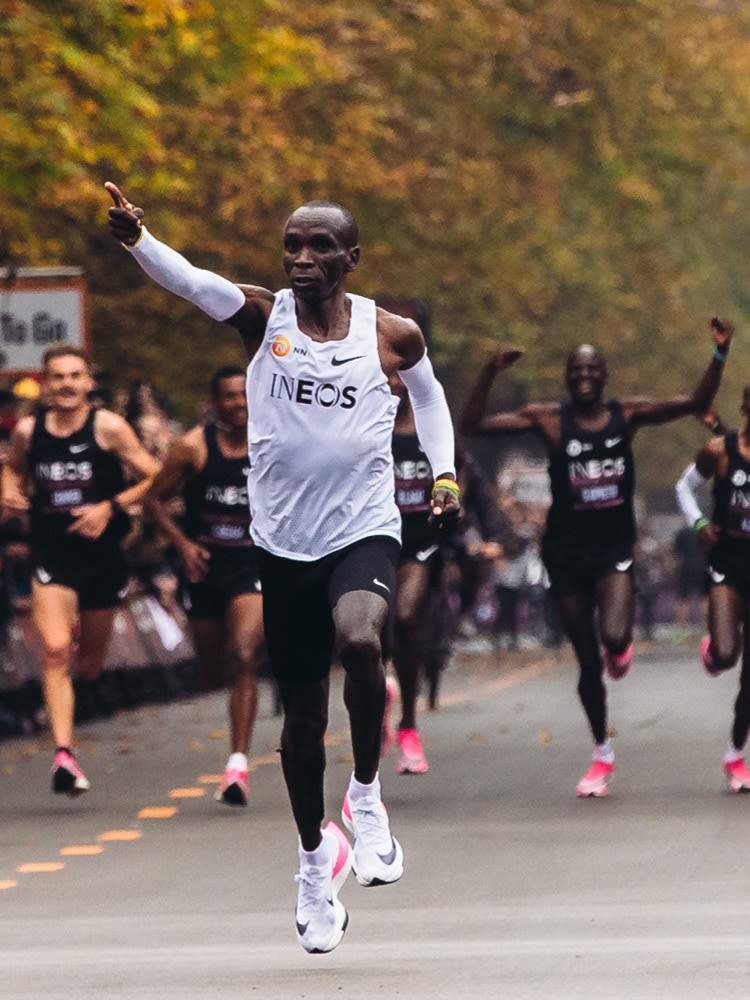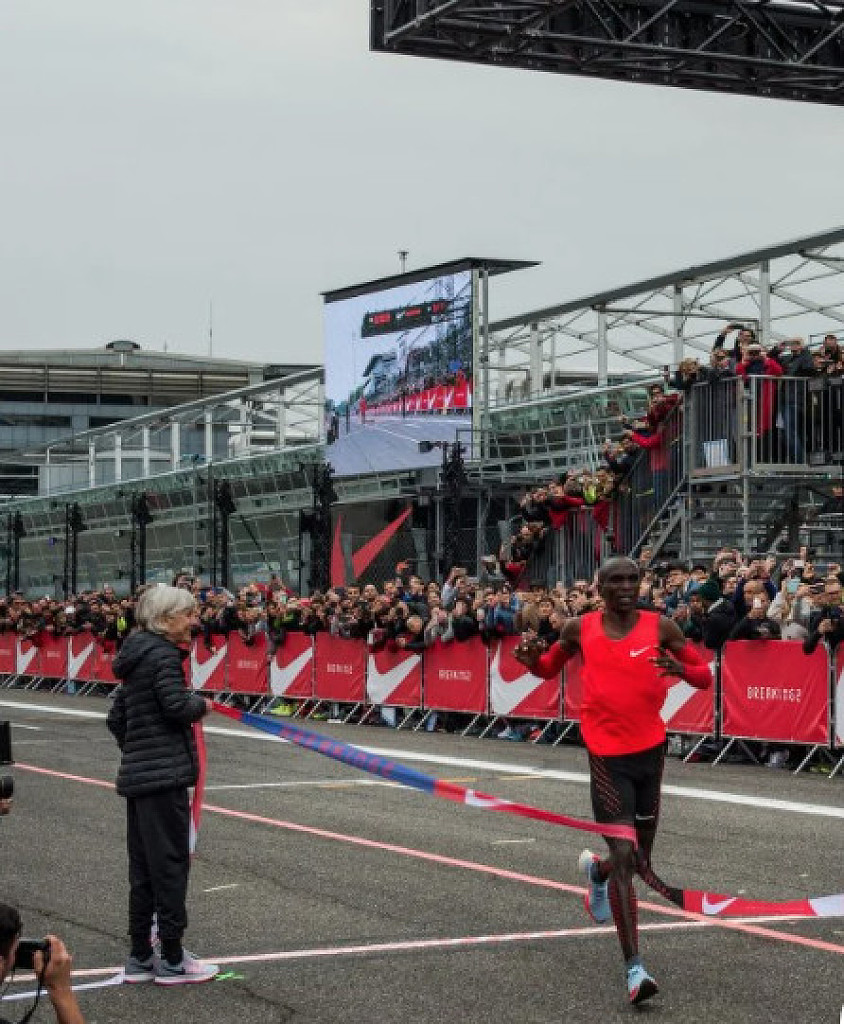Running News Daily
Running News Daily is edited by Bob Anderson. Send your news items to bob@mybestruns.com Advertising opportunities available. Train the Kenyan Way at KATA Kenya and Portugal owned and operated by Bob Anderson. Be sure to catch our movie A Long Run the movie KATA Running Camps and KATA Potato Farms - 31 now open in Kenya! https://kata.ke/
Index to Daily Posts · Sign Up For Updates · Run The World Feed
We Now Have the Lab Data on Nike's Breaking2 Runners
To pick their two-hour marathon team, researchers tested some of the greatest runners on the planet. Now they're revealing what they found.
Here’s a quick and convenient way of finding out whether you’re ready to run a two-hour marathon. Head to the track and run six laps (roughly 1.5 miles) at two-hour pace (4:34.6 per mile), then run one more lap as fast as you can. Have a nearby exercise physiologist fit you with a portable oxygen-measuring mask, to measure your energy consumption at that pace. Then crunch the data to see whether your metabolism is settling into a sustainable pattern, or whether it’s spiraling out of control toward a fiery explosion.

That’s one of several tests that at least 16 elite runners underwent during the selection process for Nike’s 2017 Breaking2 race, which Eliud Kipchoge ended up winning in 2:00:25. Now the scientists responsible, including teams from Andrew Jones’s group at the University of Exeter in Britain and the Nike Sport Research Lab in Beaverton, have published some of the data in the Journal of Applied Physiology. It’s grouped and anonymized, so we don’t get to obsess about the individual details of Eliud Kipchoge’s physiology, but it’s a pretty rare window into the characteristics of best-of-the-best runners. Here are some of the highlights.
The runners were “predominantly of East African ethnicity,” with average bests of 1:00:04 for the half marathon and 2:08:40 for the marathon at the time of testing (they’ve since run, on average, 59:53 and 2:06:53). All were drawn from the global pool of Nike-sponsored runners, with a particular focus on those with half marathon times that suggested the ability to handle two-hour pace. The only runners we know for sure were among the subjects are Kipchoge and his fellow Breaking2 finalists, Zersenay Tadese and Lelisa Desisa. The inclusion of runners like Tadese, who at the time held the half marathon world record of 58:23 but had only run 2:10:41 for the marathon, helps explain the relatively modest average marathon time.
The testing, which was completed at either the Nike campus or the University of Exeter, included a bunch of body measurements like height, weight, body fat, lung function, and the length and girth of various parts of the leg and foot. This stuff is interesting, since some researchers believe that factors like the length of the Achilles tendon can influence running economy, but there were no unusual results. Biomechanical testing of ten of the runners who were examined in Exeter found that six were forefoot strikers and four were heel strikers, and the most efficient runners had the shortest ground contact time with each step. Again, this is more or less what you’d expect based on previous studies of elite runners.
They also did a VO2 max test on the treadmill, with the speed increased in stages until the runners gave up. Between each treadmill stage, the runners hopped off the treadmill briefly to have their fingers pricked for a lactate measurement to determine their lactate threshold. Here there were some more surprising results. The average VO2 max was just 71.0 ml/kg/min, which is unexpectedly low given that the range expected for elite endurance athletes is typically about 70 to 85. The lowest value among the Nike runners was 62, which is astonishingly low, and the highest was 84, which is high but far from unprecedented. You can think of VO2 max as the size of the aerobic engine; whatever gifts made these runners special, it apparently wasn’t having a huge engine.
You’d expect, then, that they must be extraordinarily efficient. Their running economy, which is a measure of how much energy you burn at a given pace, was indeed pretty good, averaging 189 ml/kg/km on the treadmill. That’s consistent with previous studies that found typical values of around 190 ml/kg/km in elite runners (and substantially better than the values of 210 or higher seen in recreational runners at slower paces), although there was a lot of individual variation between the most and least economical. As in previous studies, there was an inverse relationship between VO2 max and running economy: those with the highest VO2 max tended to have the worst economy, and vice versa. Whether that’s inevitable for some physiological reason, or simply a reflection of the fact that even elite runners are unlikely to hit the genetic lottery twice, remains a topic of spirited debate.
To measure running economy, you have to be running aerobically, since oxygen consumption is used as a proxy for energy consumption. If you’re having to burn a lot of anaerobic energy to maintain the pace, the energy estimate will be inaccurate. Interestingly, only seven of the 16 runners were able to fulfill this requirement while running at 2:00 marathon pace. The other nine were above their “critical speed” at that pace, which tells you pretty much right away that they had no hope whatsoever of running a two-hour marathon. (To be fair, the testing had to be slotted in between seasons for some of the runners, so they may not have been in peak condition.)
In the classic mathematical model of marathon performance, there are three variables: VO2 max, running economy, and a third variable that represents what fraction of VO2 max you’re able to sustain over the course of a marathon. That third variable is often approximated by the lactate threshold, which is the speed at which your lactate levels begin to gradually creep up as you start relying more on anaerobic energy.
But well-trained marathon runners are actually able to run the distance at a slightly higher speed than their lactate threshold. In this study, the runners hit their lactate threshold at 83 percent of VO2 max on average. Their critical speed, which is roughly when lactate levels start shooting up more steeply instead of just creeping up, occurred at 92 percent of VO2 max. Marathon pace tends to be somewhere between those two markers. In fact, a previous study by Jones and Anni Vanhatalo found that elite marathoners tend to run their marathons at 96 percent of critical speed, which in this case works out to 88 percent of VO2 max.
If you run the numbers, using lactate threshold as marathon pace predicts that the runners in the study should average 2:15:24 for the marathon. Using critical speed predicts 2:02:55. Using the Goldilocks value of 88 percent of VO2 max, in contrast, gives a prediction of 2:08:31—almost exactly corresponding to their average best time at the time of testing, which was 2:08:40. The takeaway: your critical speed (which you can calculate as described here) offers a pretty good estimate of marathon pace, assuming your training is adequately geared for the distance.
After all this testing, the team selected Kipchoge, Desisa, and Tadese. Kipchoge turned out to be a great choice. Desisa is a mixed bag: he was injured before Breaking2, and hasn’t run particularly fast since, but he did win last year’s World Championships and also won New York in 2018 and was second in Boston in 2019. You could do worse. Tadese, on the other hand, has never really managed to put it together in the marathon, despite stellar lab values (in earlier testing, he had the best running economy ever measured).
What was missing for Tadese? Jones and his colleagues suggest that the mathematical model needs a fourth variable, which they call “fatigue resistance,” representing “the extent of the deterioration of the three [other variables] over time.” A previous study from the Breaking2 researchers explored how critical speed changes over two hours of exercise. The gist: it gets worse, and some people have a greater decline than others. Maybe Kipchoge is unusually gifted in this regard; maybe Tadese got dealt a weak hand. It seems clear that fatigue resistance is an important ingredient for marathon success, but the problem for running scientists is that there’s no convenient way of measuring it—other than, well, running a marathon.
For more Sweat Science, join me on Twitter and Facebook, sign up for the email newsletter, and check out my book Endure: Mind, Body, and the Curiously Elastic Limits of Human Performance.
by Outside
Login to leave a comment




